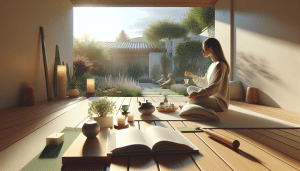Simple Living Ideas That Can Inspire You
Jessica White October 18, 2025
Explore the world of simple living and discover how intentional habits, decluttering, and mindful entertainment can make daily life more joyful. This article guides you through practical ideas that many find valuable for improving well-being and creating a more fulfilling lifestyle.
Embracing Minimalism for Everyday Joy
Minimalism isn’t just a trend; for many, it’s a meaningful way to reduce stress and increase contentment. Removing excess clutter from living spaces can have a tremendous impact on both psychological and physical well-being. People often feel lighter and more focused after donating or recycling things they no longer need. Small changes, such as keeping counters clear or organizing digital files, foster an atmosphere of calm that supports better sleep and productivity.
The concept of ‘less is more’ extends beyond the home. Mindful shopping encourages thoughtful consumption, challenging consumers to buy only what genuinely adds value to their lives. Those who practice this often develop a stronger sense of appreciation for their belongings. Gifts are chosen with intention, and purchases are weighed for lasting impact. In turn, this approach helps reduce financial strain and lessens environmental waste, two outcomes that many find motivating.
Minimalist living doesn’t require radical sacrifice. Start by setting aside five minutes each day to tidy a small area or delete unused phone apps. This gentle method builds confidence. Over time, routines like the one-in, one-out rule—removing one possession for every new item brought in—can transform any space gradually. The satisfaction of seeing clearer countertops and quieter inboxes brings daily moments of happiness for many simple living enthusiasts.
The Art of Creating a Cozy Home Environment
A cozy home environment is central to simple living and intentional entertainment. Lighting, textures, and personal touches can uplift any mood. Soft throws, indoor plants, and soft, natural lighting create inviting spaces to relax after a long day. Many find that choosing soothing color palettes—such as warm neutrals or earth tones—makes rooms feel more harmonious and calming. These little changes are accessible to all and often lead to greater happiness at home.
Comfort doesn’t have to come with a hefty price tag. Rearranging furniture for better flow can make a dramatic difference in how a room feels. Removing items that no longer spark joy or serve a function clears the way for meaningful pieces to stand out. Displaying personal artwork or photographs makes a space uniquely personal, while multipurpose furniture can be both practical and visually appealing.
Coziness thrives when coupled with mindful routines. Evening rituals, such as reading or journaling in a favorite chair, help set a positive tone before bed. Hosting quiet gatherings with close friends, surrounded by candles or gentle music, offers entertainment without digital distractions. People often report that creating a sanctuary at home boosts relaxation and provides an anchor during stressful times.
Mindful Entertainment for Enriching Free Time
Choosing entertainment that nurtures well-being is a cornerstone of simple living. Swapping endless scrolling or binge-watching for creative hobbies yields lasting satisfaction. Activities like painting, music, or crafting let people express themselves and connect to deeper joys. Discovering the satisfaction in gardening, puzzles, or learning an instrument brings a unique sense of accomplishment. These pursuits can be shared with friends or enjoyed solo for a break from busyness.
Intentional leisure often leads to discovering new passions. For example, many have found value in joining local book clubs or nature-walking groups, benefiting from both social connection and mental stimulation. Cooking at home can become both entertainment and nourishment, with the chance to experiment with healthier recipes. Others find fulfillment in volunteering or supporting community events, experiencing the joy of making a difference.
Mindful entertainment encourages balance. Setting boundaries around screen time or scheduling regular tech-free evenings gives the mind a chance to unwind and recharge. This can be paired with meditative activities, such as yoga or listening to calming music, for a holistic approach to downtime. Those who embrace these practices often notice improved concentration, creativity, and general satisfaction in everyday life.
Decluttering Digital Life for Mental Clarity
Digital clutter can be as overwhelming as physical clutter. Inbox overload, endless notifications, and crowded desktops often hinder productivity and well-being. Many people start digital decluttering by unsubscribing from unnecessary emails and deleting unused apps. Creating organized folders and using digital calendars can make finding information easier and reduce stress, especially during busy weeks.
A deliberate approach to technology use builds boundaries that protect mental health. Strategies like limiting social media time, scheduling tech-free breaks, and turning off nonessential notifications foster greater focus. People frequently experience better sleep and mood when screens are kept out of bedrooms or evening routines. Such boundaries support more meaningful, in-person connections.
Decluttering digital life is an ongoing process. Setting aside time each week to clean up files and emails prevents overwhelm from accumulating. Simple habits—like marking important messages, archiving old photos, or using password managers—bring peace of mind. Over time, these routines create space for what truly matters and allow for more thoughtful engagement with technology.
Bringing Nature and Movement Into Daily Routine
Nature is a powerful ally in simple living. Regular walks in parks, tending to houseplants, or simply opening a window to fresh air can lift energy and soothe the mind. Studies show that spending time outdoors reduces stress and enhances mood. Even city dwellers can benefit from window boxes, balcony gardens, or visits to local green spaces.
Movement doesn’t require an expensive gym membership; small changes bring big benefits. Stretching, yoga, or dancing in a living room can be integrated easily into daily routines. Many appreciate how regular movement improves sleep, strengthens the immune system, and supports emotional balance. It’s also a simple way to reconnect with the body after hours at a desk.
Nurturing a connection to nature and movement encourages other healthy habits. Preparing meals from local produce, noticing seasonal changes, or practicing mindfulness outdoors foster appreciation for life’s rhythms. People often report an increased sense of gratitude, creativity, and resilience when they make time for these activities, highlighting their central role in a contented lifestyle.
Cultivating Gratitude and Mindful Relationships
Gratitude is at the heart of simple living. Keeping a gratitude journal, writing thank-you notes, or sharing positive reflections with loved ones helps reframe everyday challenges. Scientists have found that practicing gratitude regularly can boost happiness and improve health outcomes. These small practices make even everyday moments feel more meaningful and rewarding.
Mindful relationships are built on presence and empathy. Setting aside uninterrupted time for conversation, listening with attention, and expressing genuine appreciation deepen connections. Digital boundaries—like keeping phones off during meals—support richer, more satisfying interactions. These mindful practices help people weather stress and find joy in shared experiences.
Building community can involve simple acts, such as checking in with neighbors or gathering for shared activities. Hosting potlucks, volunteering for local projects, or participating in group mindfulness sessions nurture a sense of belonging. The rewards—stronger social networks, reduced loneliness, and increased life satisfaction—show the power of intentional, gratitude-centered living.
References
1. Kondo, M. (2014). The Life-Changing Magic of Tidying Up: The Japanese Art of Decluttering and Organizing. Retrieved from https://www.nytimes.com/2014/10/23/garden/marie-kondo-and-the-tidying-up-trend.html
2. National Sleep Foundation. (n.d.). How Light Affects Our Sleep. Retrieved from https://www.sleepfoundation.org/physical-health/lights-and-sleep
3. American Psychological Association. (2019). Why Gratitude Is Good. Retrieved from https://www.apa.org/monitor/2019/01/ce-corner
4. Harvard Health Publishing. (2021). Exercising to Relax. Retrieved from https://www.health.harvard.edu/staying-healthy/exercising-to-relax
5. The Center for Humane Technology. (n.d.). Digital Well-Being. Retrieved from https://www.humanetech.com/
6. Greater Good Science Center. (n.d.). The Science of Gratitude. Retrieved from https://greatergood.berkeley.edu/topic/gratitude/definition








